
Review
"Surviving Mars: Relaunched" is a successful remake
by Debora Pape

City building simulator Foundation by indie developer Polymorph Games is now finished. The game is a feast for the eyes and incredibly fun because every settlement looks different.
While my villagers bustle busily along the paths they’ve trodden themselves, I consider how I can best integrate my monastery buildings into the landscape. Then I watch my soldiers training on dummies before I send them on a dangerous mission in the neighbouring country. With luck, the survivors will bring me valuable spoils of war – in the best-case scenario, they’ll include blueprints for unique monuments.
Foundation offers the most organic and creative city building I’ve ever played. In terms of gameplay, it’s somewhere near The Settlers, Cities: Skylines and indie game Ostriv. The game left its Early Access phase on 31 January 2025 after exactly six years and was released in full with a major patch.
It’s a medieval-style city builder with a focus on hustle and bustle and creativity. The comic-like graphics underline the relaxed, peaceful gameplay. There are no fights and no slain soldiers or even slaughtered citizens – and that’s despite me building a military camp, training soldiers, erecting fortifications and sending militia on patrol through the city. More on that later.
I’ve been playing Foundation since the start of Early Access and have begun a new save game almost every year during this time. With the 1.0 patch, Canadian developer studio Polymorph Games has again changed the look of the game significantly.
If you were already familiar with Foundation, you’ll probably hardly recognise the game now. All the buildings and the entire visual appearance of the game have been reworked. There are new animations, new models and various changes to the mechanics. You can read all the changes in detail in the patch notes.
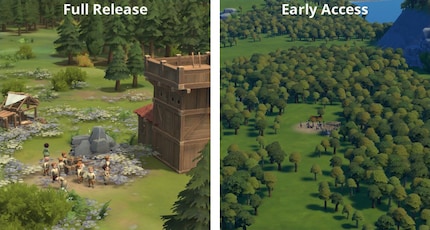
In this review, I’ll also show you screenshots of my cities from the Early Access to give you insights into the late game.
In Foundation – as in many other city building games – I start on a green field. I have ten villagers at my disposal to start with. They’re serfs satisfied with having a roof over their heads and something to eat. I can level them up to demanding citizens later.
First, I build a site hut and assign three workers to it. As soon as there’s something to build somewhere, the three of them go off, get the necessary materials and go to the construction site. One of these trips is to a lumber camp, which I place in the forest. Once it’s finished, it produces a steady supply of wood. There’s no grid aligning buildings or roads, I position production buildings completely freely.
My villagers call the shots when it comes to residential buildings. I use a green brush to mark where residential buildings can be built. They then take care of the placement themselves when they need new houses. You may know this principle from games such as Sim City or Cities: Skylines.
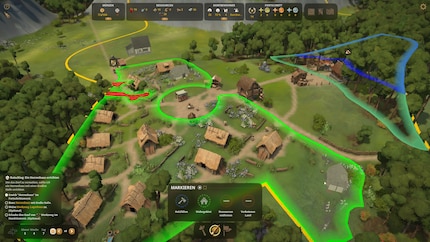
The big difference is that the houses in Foundation are built more or less chaotically. Right angles are more of an accident. AI places the plots precisely in the marked zones so there are no unused areas in the corners of a residential area. No two plots are the same.
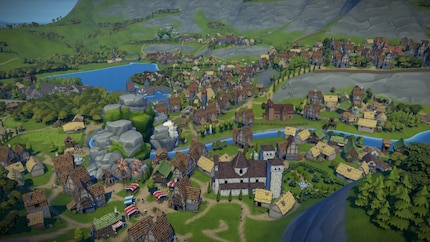
AI leaves open spaces between plots for possible roads. This can be seen from fences at property boundaries. But instead of using this and establishing a logical network of paths, my citizens prefer to walk shorter routes directly through other people’s gardens. This somehow makes the fences obsolete, and I hope this’ll be adjusted going forward. Foundation is definitely a dream for players like me who want to see their cities grow as crookedly and organically as possible.
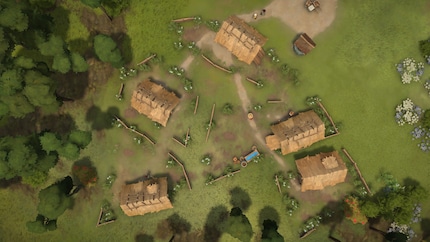
I get new citizens when the level of satisfaction in the village is high, as travellers stop and ask to be taken in. That makes me happy – after all, more workers are always welcome.
The second difference compared to most other city building simulators is road construction. In Foundation, I don’t build the roads; they gradually emerge where my busy bees run around. If they keep walking the same routes, a path forms on the ground. And vice versa: if one’s no longer used – for example because I tear down the house at the end of the path – it slowly disappears again. Trampling new paths into the ground where it seems advantageous is human nature – I love this realism.
If I don’t like what my citizens are doing – for example, because I want them to take a detour through my self-built park – I help indirectly. In the same way that I draw residential zones on the map, I draw red prohibition zones to block off unpopular streets and force people to find other routes.
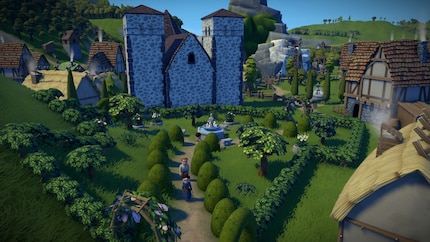
Redirecting citizens through restricted zones worked very well in Early Access, but now the little rascals like to bypass my barriers and carry on walking through areas I want to keep clear of paths, such as right across fields. The farmers should be able to work the fields, obviously, but I don’t want to see everyone walking across them.
Polymorph still has some work to do on pathfinding. I was also quite surprised by a path that leads to my town. It runs almost entirely straight – regardless of there being an almost vertical rocky outcrop in the way.

Anyone who knows The Settlers will also know about the hustle and bustle factor: it’s fun to watch the busy villagers at work and enjoy life on the streets. In Foundation, all of the professions have their own specific clothes and tools and you can see them working outside their houses – even the baker and the tailor. I can also keep sheep and cattle, with the tinkling of their neck bells and their grazing and mooing adding to the artisanal backdrop of knocking, hammering and grinding. Since the full release, I can finally hear a busy murmur when I zoom in close to the village. I always used to find the villagers – who’d been quiet until then – a bit creepy.
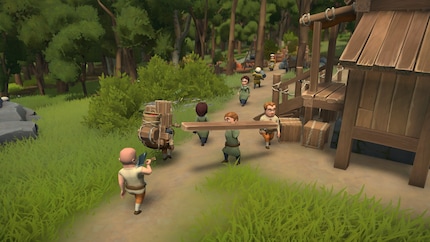
In their free time, my residents buy goods from the market. The market’s modular: each product requires its own stand. A few years ago, the money for each individual purchase went into my coffers with a happy jingle. Now, citizens receive all goods for free and are taxed instead.
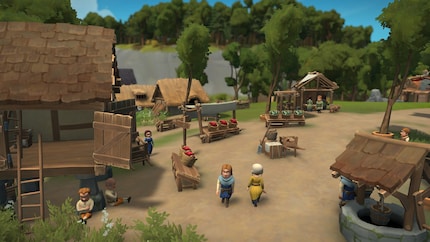
As the game progresses, I unlock blueprints for special buildings, such as the manor house, churches, the monastery, the military fort, and large ornamental fountains. Like the market, these buildings are modular and consist of several building sections, some of which have different functions.
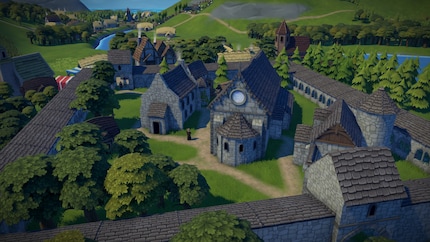
A church, for example, needs at least one main building, a bell tower and a door. But I can also build several towers, and various extensions enable me to increase the available space for my community. The church is important because my villagers have a need for faith. Only when all their needs are satisfied can I promote them to a higher citizen class.
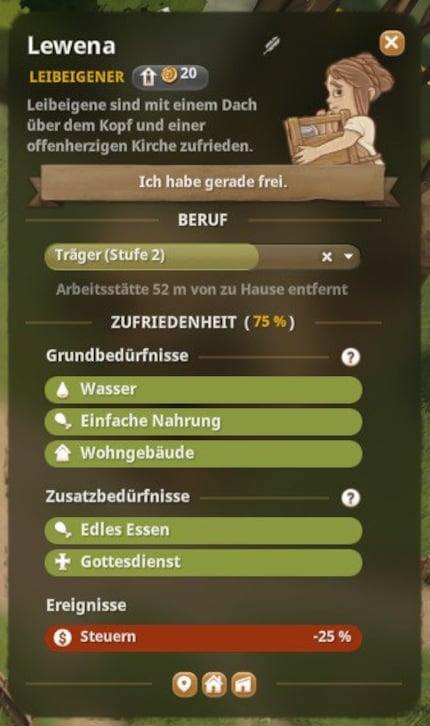
I’m free to position the different parts of the building so that my churches look completely unique. What’s new in the full release is that even simple production buildings like the lumber camp can be expanded and made more efficient.
The manor house, which serves as an administrative building, has also grown. A treasury gives the tax collector somewhere to work, and extensions for a larger treasury allow me to hoard more gold. I create space for the bailiff in an extra tower. I assign him tasks and send him to search for ore, for example.
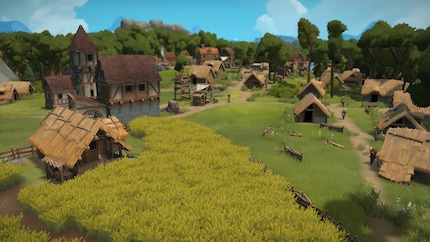
Patrols and watchtowers are completely new additions for the full release. The existing palisades now also have a useful purpose: for the city to grow and prosper, my citizens have to feel safe. This means they need fortifications such as palisades or watchtowers as well as patrols to check the streets are safe.
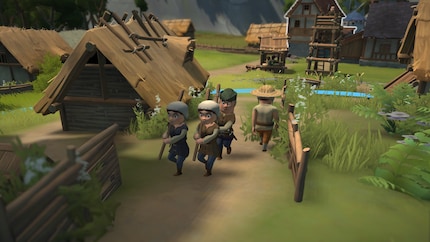
There’s also the military. By building a castle and going on campaigns with my small army, I collect reputation points from the king, which I use to unlock new buildings and advantages. I haven’t seen this in the full release version yet, so I’m thinking back to my experiences from Early Access. As soon as I’ve built the defence tower as the basis for a later fort, I start recruiting soldiers. If I give them a weapon and training dummies, they start running through drills.
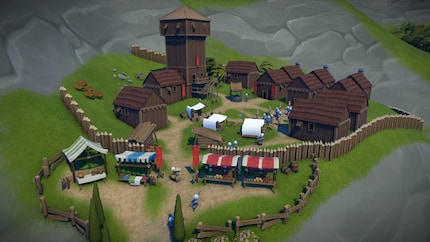
In Foundation, there are soldiers, but no battles. I can only send my troops on missions «abroad». The success and possible spoils of military missions depend on the number of soldiers and their level of training.
After being assigned a mission, the troops assemble and march in single file to the edge of the map. If they return victorious a few days later, they usually bring back money, resources and sometimes a blueprint for monuments such as new church styles or magnificent fountains, which can even have special effects. Some soldiers are injured in the war and need to be healed. Others never return.
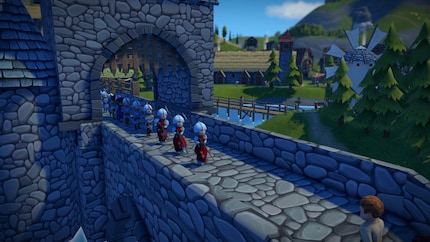
In contrast to soldiers, monks have a safe job. Provided they have the appropriate monastery modules, they make various products I wouldn’t have otherwise. For example, I can give the monks (or nuns) a vineyard, a herb garden and beehives.
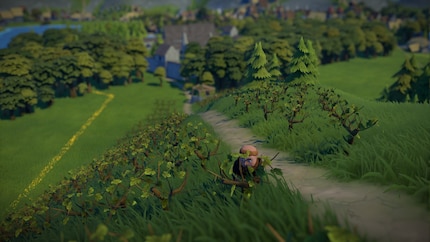
Unlike the Anno games, Foundation doesn’t place as much emphasis on supply chain optimisation. There are no production diagrams, and I hire new craftspeople based on a rough estimate rather than calculated needs. I like that.
Sometimes, however, there aren’t enough informative overlays. For example, I can’t see how far a market covers, so I only build another market if I feel the old one’s selling out too quickly. The same goes for the treasurer who collects my taxes. A tip in the loading menu says that having several treasurers is worthwhile for larger towns. But I don’t know when exactly.
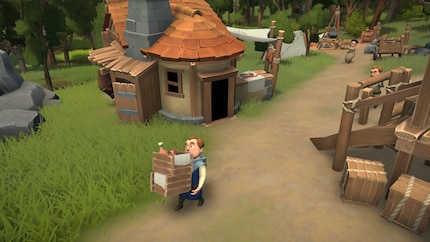
But I think that’s fine. Precise information overlays would mean that I always place my buildings at the most efficient distances, like in Anno. And that’s exactly what I don’t want in my small, organically grown and somewhat inefficient settlement.
Foundation has been available on Steam for PC since 31 January 2025.
Foundation was love at first sight for me. I even liked it in the rough Early Access phase, and a lot has changed over the years. It’s one of the most carefully made, busy games out there at the moment, and the many modular buildings offer much more scope for creativity than other construction games.
When I first saw the full release version, my first thought was: «How did they manage to make the game even better?» Not only has the overall look got even better, details have also been improved and adjusted.
The developers are sure to improve a few annoying points. These include my citizens’ tendency to take shortcuts and the lack of notifications about important events such as new arrivals in my city. Both of these worked better in Early Access.
Pro
Contra
Feels just as comfortable in front of a gaming PC as she does in a hammock in the garden. Likes the Roman Empire, container ships and science fiction books. Focuses mostly on unearthing news stories about IT and smart products.
Which films, shows, books, games or board games are genuinely great? Recommendations from our personal experience.
Show all